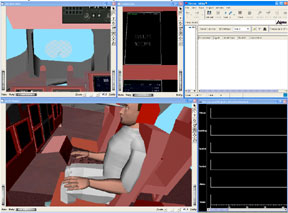 |
 |
 |
|
|
 |
|
| |
|
|
|
|
|
| |
MIDAS 3.0 |
| |
|
|
|
|
|
| |
Although
application
directed
work
with
the
existing
software
comprises
half
of
the
program's
funding,
a
major
effort
to
rearchitect
the
MIDAS
system
is
also
underway.
The
goals
driving
this
redesign
include
decreasing
development
time
for
new
scenarios
(from
several
months
to
one
or
two
weeks),
increasing
the
efficiency
of
the
running
system
(from
around
50
times
real-
time
to
near
real-
time),
facilitating
the
process
of
replacing
cognitive
and
perceptual
models
(from
weeks
to
days),
and
expanding
the
functionality
of
the
system
as
detailed
below.
Presently,
MIDAS
is
implemented
in
a
combination
of
C/C++
and
LISP,
with
the
human
performance
elements
being
largely
LISP-
based.
As
a
result,
supporting
the
interaction
of
modules
in
different
languages
and
trying
to
map
design
concepts
uniformly
across
very
different
programming
paradigms
(e.g.,
the
notion
of
agent),
has
proved
difficult.
In
addition,
while
it
began
with
a
fairly
rigorous
design
process,
over
the
years
MIDAS
has
acquired
a
number
of
idiosyncratic
and
hard-wired
features,
simply
due
to
time
constraints
and
the
nature
of
complex
software
evolution.
The
resulting
system
is
difficult
to
learn,
maintain,
and
modify.
There
was
also
a
desire
to
update
the
human
operator
model
-
in
particular
to
account
for
more
widely
accepted
views
on
human
information
processing
and
its
likely
underlying
architecture.
For
these
reasons,
a
research
phase
is
underway
with
the
goal
of
redesigning
MIDAS
using
object-oriented
techniques
and
implementing
the
system
entirely
in
C++.
While
human
factors
analysis
will
remain
the
key
purpose
of
the
system,
the
new
design
was
not
intended
to
map
directly
to
the
existing
version
of
MIDAS.
Further,
the
described
applications
and
other
research
in
human
modeling
demanded
expanded
functionality
for
the
system
in
several
areas.
These
included
enhancements
of
the
human
operator
model
to
encompass
more
complete
notions
of
attention
and
working
memory,
as
well
as
support
for
modeling
multiple
human
operators
and
their
interactions.
Further
emphasis
also
needed
to
be
placed
on
the
human-computer
interface
of
the
system,
as
well
as
adding
an
explicit
simulation
analysis
environment
to
enable
a
more
complete
examination
of
simulation
results.
The
approach
taken
in
MIDAS'
redesign
is
object-oriented
rapid
prototyping.
Initial
design
efforts
produced
a
high-level
system
architecture
with
the
following
elements:
a
domain
model
supporting
components
necessary
for
running
a
simulation;
a
graphics
system
to
enable
simulation
visualization;
an
interface
for
end
user
specification
of
the
target
domain
models;
a
simulation
system
for
controlling
the
simulation
and
collecting
data
therefrom;
and
a
results
analysis
system
for
examining
simulation
data
after
it
has
been
collected.
 The latest and most current version of MIDAS integrates the Apex architecture into the MIDAS architecture. Apex: MIDAS is a tool for rapidly developing 3-D models and simulations of human performance in complex operational environments, for example, modeling how an astronaut would use a new display interface. Apex is an autonomy architecture that provides the decision-making model for the simulated human (operator) in MIDAS. Procedural knowledge for each operator is encoded in Apex's Procedure Description Language (PDL). As the MIDAS simulation runs, sensory events (visual and auditory) are passed to Apex, which responds by invoking behaviors in the operator as specified in its active procedures. Apex also includes Sherpa, a visualization tool that provides detailed views of the operator's procedure execution status and event history with task timelines. The latest and most current version of MIDAS integrates the Apex architecture into the MIDAS architecture. Apex: MIDAS is a tool for rapidly developing 3-D models and simulations of human performance in complex operational environments, for example, modeling how an astronaut would use a new display interface. Apex is an autonomy architecture that provides the decision-making model for the simulated human (operator) in MIDAS. Procedural knowledge for each operator is encoded in Apex's Procedure Description Language (PDL). As the MIDAS simulation runs, sensory events (visual and auditory) are passed to Apex, which responds by invoking behaviors in the operator as specified in its active procedures. Apex also includes Sherpa, a visualization tool that provides detailed views of the operator's procedure execution status and event history with task timelines.
MIDAS is now an agent-based architecture that includes additional multitasking and scheduling capabilities in response to environmental and other human-related constraints. This version of MIDAS is currently being applied to Crew Exploration Vehicle simulations to validly replicate human-in-the-loop performance conducted in the ISIS laboratory. This version of MIDAS is a 3-D rapid prototyping human performance modeling and simulation environment that produces quantitative predictions of human-system safety (resource use and allocation). MIDAS with Apex supports the design of automation, crew stations and operating procedures, and reduces design cycle time. MIDAS/Apex adheres to a both top-down and bottom-up modeling approaches through its integrated structure. This integrated structure allows generation of emergent behaviors. In addition, it is packaged into a consistent integrated computer desktop development environment. This desktop environment allows users to enter procedures, populate the environment, examine run-time visualization, analyze workload (6-channel), analyze situation awareness, performance error predictions, and conduct safety evaluations. MIDAS/Apex provides a number of augmentation to the existing MIDAS architecture. MIDAS/Apex provides advanced decision-making support for enabling multi-tasking and resource scheduling models; a unified query system that supports event, state, and temporal reasoning; allows fast time simulation data to be used from an outside source; permits use of visualization tools to increase system safety. |
| |
| |
|
|
|
|
|
|
|
|